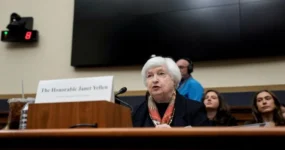The amount of reserves underlying the US banking system remains plentiful, according to a Federal Reserve Bank of New York gauge that will be published monthly.
Most Read from Bloomberg
- Inside the ‘Utopias’ of Mexico City
- One City’s Plan to Re-Link a Neighborhood That Robert Moses Divided
- How Mexico City Averted All-Out Drought
- Chicago Should Consider Furloughs, Higher Booze Tax, Watchdog Says
- Mexico Seeks to Halve Permitting Time to Attract More Factories
The first estimates of Reserve Demand Elasticity released on Thursday suggest that reserves were still abundant as of Oct. 11, according to the New York Fed. The data offers the latest evidence that the US central bank can keep removing liquidity from the system via its quantitative tightening program.
Wall Street strategists had expected the barometer to indicate that reserves are ample. Barclays Plc’s Joseph Abate this week pointed out that such a reading means the Fed could continue QT into 2025.
“The Fed seems to be using this new tool as a canary in the coal mine for reserve scarcity,” said Gennadiy Goldberg, head of US interest rate strategy at TD Securities. “From a risk-reward standpoint, it makes sense for the Fed to be more cautious on further balance-sheet runoff.”
The Fed has been winding down its holdings since 2022, gradually increasing the amount of Treasury and mortgage bonds allowed to run off its balance sheet without being reinvested. The central bank’s assets peaked at $95 billion per month, and in June, it lowered the sum of Treasuries allowed to roll off to $25 billion from $60 billion.
Measuring Abundance
RDE is a real-time assessment of the abundance of US bank reserves, calculated using data on federal funds transactions and the aggregate amount of reserves of depository institutions collected by the central bank. The estimate also uses daily data on the interest on reserve balances rate, as well as weekly data on commercial banks’ total assets.
In a blog post, New York Fed head of banking studies Gara Afonso and others wrote that the average level of the RDE was consistently close to zero from late 2014 through the end of 2017 given the ampleness of reserves in the system.
The fed funds rate became more sensitive to reserves as the Fed unwound its balance sheet in 2018 and 2019, pushing the slope of the demand curve to negative levels. That eventually spurred dysfunction in funding markets, which is still evoked by Wall Street strategists as they assess the Fed’s current runoff program.
RDE, however, returned to roughly zero as the central bank injected liquidity in the banking system in order to retain control of short-term interest rates. The New York Fed said the latest estimates are “indistinguishable from zero, meaning that the federal funds rate does not significantly respond to shifts in reserve supply,” according to a statement.
Bank reserves are about $3.2 trillion, according to the latest data.
To TD’s Goldberg, it’s logical for the Fed to take a more cautious approach as it carries out QT this time “to avoid a repeat of the September 2019 episode as we go into the debt ceiling period next year.”
Most Read from Bloomberg Businessweek
- BYD Is Winning the Global Race to Make Cheaper EVs
- A Fentanyl Vaccine Is a Long Shot That Just Might Work
- How Starbucks Became a Sugary Teen Emporium
- The World’s Central Banks Aren’t Following the Fed’s Lead Anymore
- Why OpenAI Is at War With an Obscure Idea Man
©2024 Bloomberg L.P.


